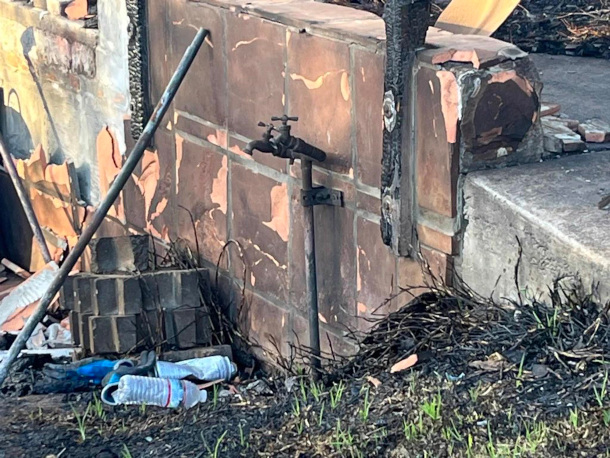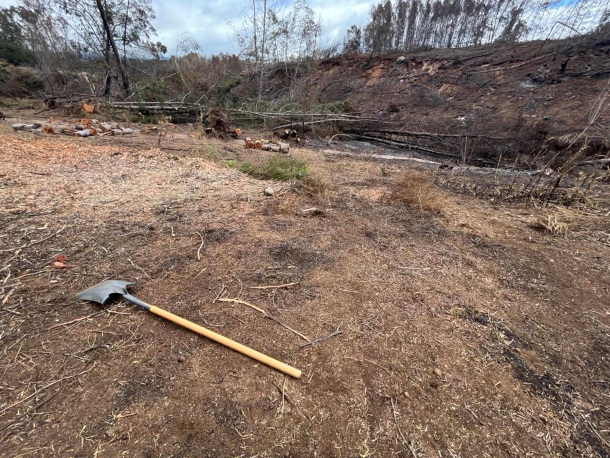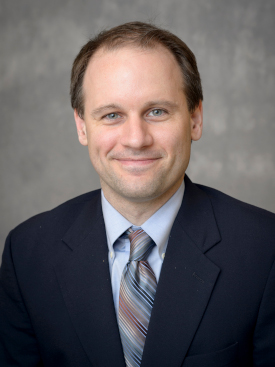Maui's Toxic Landscape
Air Date: Week of September 8, 2023

This is an area impacted by the Kula Fire visited by Professor Andrew Whelton. (Photo: Andrew Whelton)
The wildfires that killed more than 100 people and displaced thousands on the Hawaiian island of Maui left in their wake a toxic mess of melted and charred metals, plastics and more. Andrew Whelton, a Professor of Civil Environmental and Ecological Engineering at Purdue University, recently returned from Maui to help assess the risks and joins Host Jenni Doering to explain how testing air, water, and soil can keep communities safe from contamination as they rebuild.
Transcript
BELTRAN: It’s Living on Earth, I’m Paloma Beltran
DOERING: And I’m Jenni Doering.
This summer has brought no shortage of climate trauma. Heatwaves across the world, supercharged hurricanes in the Atlantic and Pacific, and floods in India, China, and Turkey. Wildfires have scorched Canada, Greece and Hawaii, where blazes on the island of Maui killed more than 100 people and displaced thousands. And with neighborhoods in ruins, the danger is far from over. The homes and shops that burned in the fires are now a toxic mess of melted and charred metals, plastics, and more. Locals have been getting some help understanding the risks and how to safely go about cleaning up the debris from people including Andrew Whelton, a Professor of Civil Environmental and Ecological Engineering at Purdue University. He and his team helped assess contamination and water safety issues after the 2017 Tubbs Fire and the Camp Fire just a year later in California, and the 2021 Marshall fire in Colorado. Professor Whelton recently returned from the communities of Lahaina and Kula on Maui and joins me now. Welcome to Living on Earth, Andrew.
WHELTON: Thanks for having me.
DOERING: What kind of toxic waste usually results from fires like the one we saw in Lahaina, Maui. What hazardous materials are we talking about?
WHELTON: Well, several days after the fires were put out, US EPA and other agency officials went in to start removing and separating hazardous waste and hazardous materials from the property so that it can start to be cleaned. These types of things include paints, propane tanks, other chemical materials that may pose a health risk, and you can't necessarily pick them up and put them into a truck and send them to a landfill, you have to separate these things. There was also concerns about many of the homes that were destroyed, were made of asbestos, there was asbestos parts of it and so under living conditions, asbestos doesn't necessarily pose a hazard. But once the structures are destroyed, that asbestos can be released into the air and the environment and then pose an immediate health risk to everybody around them. Fires like we saw in Lahaina and Kula can exceed 2,000 degrees Fahrenheit, sometimes even burn hotter. And this sometimes can cause metals to deform in some cases melt. So you can have metals on cars kind of melt out and then cool right underneath the cars. Or, you can have tires burn, which are plastics and other plastics in buildings and infrastructure. When these materials burn, they create all sorts of new chemicals that were not necessarily present in the parent product. And those can be released into the air, they can release into the water, or they can form particles that deposit on the ground and nearby that can run off and pose inhalation or exposure risks.

Several properties had observed plumbing damage. Some were uninhabitable. In Kula, the community fought the fire itself with hoses and water tanks until the fire department arrived. There are some harrowing stories. (Photo: Andrew Whelton)
DOERING: And are these chemicals that it'd be very clear if they're smelling in the air or tasting in the water? Or are some of these, you know, harder to detect and not necessarily obvious to people in the area?
WHELTON: Many of the chemicals that are produced when you for example, burn plastics, can be immediately harmful. And some of them you can smell at levels before they cause harm. And others you cannot. For example, benzene, you can smell benzene in drinking water at 2,000 parts per billion. But it's immediately harmful at 200 parts per billion. So you wouldn't necessarily be able to smell it, which is why officials need to do extensive environmental and water testing of the area to find and then remove these threats from the communities that were impacted.
DOERING: And how do they decide what kinds of chemicals to test for? I mean, I know that in trying to ensure that PFAS chemicals are not contaminating water systems, we're not testing for all of the PFS chemicals that are out there. There's really just a handful that we test for. So how do people who are trying to keep the people in Maui safe decide which chemicals are most important to test for?
Lots of drinking water safety questions - and rightly so.
— Andrew Whelton ????????❄️???? (@TheWheltonGroup) August 20, 2023
Residents have seen water utility staff put sampling and have told them they appreciate them.
We’ve been taking samples too with @UHawaiiNews collaborators.
8/n pic.twitter.com/u7nsX4Af38
WHELTON: That's a great question. And generally what happens is right after a disaster testing isn't necessarily conducted. It's primarily triaging the contamination trying to stop it from moving off site. In Maui and near Lahaina, for example, Lahaina borders the ocean and so there's concerns that some of the contamination will be flushed into the ocean and then affect the coral reefs nearby. So a lot of the initial work is to protect the environment from the contamination moving off. During disaster debris removal, there are, for example, 21 different types of heavy metals that would be tested for including arsenic, cadmium, and some of the others that are used to determine whether or not the soil poses the health risks to people nearby, and whether or not additional cleanup has to happen. For drinking water. That's more nebulous and what I mean by that is, since 2017, we've been compiling a list of chemicals that show up in drinking water after wildfires but prior to 2017, there was no list and people really didn't test. So different aspects of this recovery, in how they go about testing differs based on just the level of knowledge that officials have in who they engage to help them.
DOERING: And then what about chemicals in the air? How does that testing work and what's really the big concern there?
WHELTON: One of the concerns in Maui is that the particles and dust, toxic dust from structures burning and such can be resuspended in windy days. And so while we were there, recently, there were 30 mile an hour winds and that can cause suspension of these particles in the air. Some of those not only carry with them contaminants like heavy metals, but they can be small enough that they can go deep into your lungs and impose another hazard. So one of the testing approaches that is typically used are look for particulate matter. These are particles to see you know what size, what amount of particles in the air. And then there's also other testing approaches where you try to capture and then quantify how many and what type of VOCs or volatile organic compounds are released from debris or just suspended in the air.

There were remarkable stories of residents. Many fought the fire before responders arrived. The fire moved so fast through the dry underbrush and trees. Some of the residents nearly died. Propane tanks exploded. (Photo: Andrew Whelton)
DOERING: And what if anything, can cleanup crews actually do about that dust? Is there anything they can do to prevent it from just flying around in the air?
WHELTON: Yes, what is happening in Maui is similar to what type of countermeasures were in place after the Marshall fire. So what the officials will do is they'll spray this type of polymer coating on top of the debris. And then that will prevent that debris from being suspended by air, it's kind of like a shield. And it also reduces the hazard of people walking around, say, the middle of the streets, so that they know that the debris won't find its way to where they are.
DOERING: So given all those hazards, what steps are required before communities in Maui actually begin to rebuild or move back in?
WHELTON: Well, the process right now is still in the response phase, where officials are trying to understand the scale of environmental contamination, at the same time as helping households and businesses relocate and try to stabilize their near term future. In the larger picture, it's going to be months before the debris is removed from these damaged properties. And that's primarily because of the contracting process, the government policies and procedures that have to go into selecting these contractors, we typically see debris remain on property sometimes for six months, before it's removed. And so that's why it's really important to stabilize this material, so that it doesn't run off into the waterways and the nearshore environment. So it's going to be a long process.
DOERING: You know, after a devastating fire like this sweeps through a community, there's often these pictures that we see after the event of people going back home and picking through what's left of their lives. You know, maybe finding a photograph here, a family heirloom there that somehow survived. But how is that able to happen? If there's all of this potentially hazardous stuff around in Lahaina? What does sort of picking through the remains of their lives look like there?
Some households in the Unsafe Water Alert area are relying on water buffalos for water.
— Andrew Whelton ????????❄️???? (@TheWheltonGroup) August 21, 2023
Some households don’t for various reasons we are finding.
10/n pic.twitter.com/HMKqHVHbzL
WHELTON: Well, there are some very skilled groups that will come in and help households and business owners sort through their properties. And one of them is Good Samaritan's Purse. They have the training and the safety equipment needed to go in and help people search through their property for special mementos and other things that they can recover. We actually encountered some of these professionals in Kula, and they were helping out a family who said that they just couldn't bring themselves back to go through their property. They were looking for specific things and they also had several young children who couldn't see their house because they couldn't process what was happening. For people that go and do their own searching of their property they need to wear very specific personal protective equipment, gloves, long sleeve shirts, close toed shoes, sometimes respirators, and sometimes Tyvek suits, because the materials that are there are now hazardous. And you need to protect yourself and your family from any exposures that could cause harm because we don't want this disaster to have long term health implications. And that's one way that we can help avoid that.
DOERING: Now, from what I understand you talked to elders in Lahaina about some recovery options. What did you take away from talking with them?
WHELTON: While we were in Maui, helping out the local community, University Hawaii and government agencies we did get invited to talk with the Hawaiian community. And that was an amazingly memorable experience. The Hawaiian community came together right after the fires and started helping each other, get through this disaster. The Hawaiian community was rescuing people from their cars and their homes. They were setting up convoys, to bring in bottled water and other food items to people through the beaches. And they truly have a connection with the environment and community that I have not seen anywhere else at any other disaster.

Andrew Whelton is Professor of Civil, Environmental, and Ecological Engineering at Lyles School of Civil Engineering, in Purdue University. (Photo: Courtesy of Andrew Whelton)
DOERING: Of course, a lot of the recovery effort depends on the help of government agencies, in addition to the hard work of the local community itself. What's been the communication like so far between agencies like FEMA and local communities?
WHELTON: Initially, the local communities were the ones who organized and started supporting each other. They were in many cases, the first responders, not just the firefighters.
DOERING: But everyday people basically got garden hoses and buckets and started trying to fight fires. And together, they were able to put out some spot fires.
WHELTON: FEMA and other agencies came in shortly after. And there has been some friction between these groups primarily because these agencies came in and started telling people what to do, not necessarily recognizing the trauma that the community had gone through, and the just heroic acts that the community members had done in absence of FEMA and these other agencies. And so, over the last several days, we've seen multiple meetings with these agencies and local community to try to iron out any of these remaining issues, so that the majority of energy can be focused on helping the people in a way that they need help.
DOERING: Andrew Whelton is a professor of Civil Environmental and Ecological Engineering at Purdue University. Thank you so much, Andrew.
WHELTON: Thanks for having me.
Links
PBS | “Amid Grief and Loss, Maui Residents and Businesses Continue Wildfire Recovery”
Living on Earth wants to hear from you!
Living on Earth
62 Calef Highway, Suite 212
Lee, NH 03861
Telephone: 617-287-4121
E-mail: comments@loe.org
Newsletter [Click here]
Donate to Living on Earth!
Living on Earth is an independent media program and relies entirely on contributions from listeners and institutions supporting public service. Please donate now to preserve an independent environmental voice.
NewsletterLiving on Earth offers a weekly delivery of the show's rundown to your mailbox. Sign up for our newsletter today!
 Sailors For The Sea: Be the change you want to sea.
Sailors For The Sea: Be the change you want to sea.
 The Grantham Foundation for the Protection of the Environment: Committed to protecting and improving the health of the global environment.
The Grantham Foundation for the Protection of the Environment: Committed to protecting and improving the health of the global environment.
 Contribute to Living on Earth and receive, as our gift to you, an archival print of one of Mark Seth Lender's extraordinary wildlife photographs. Follow the link to see Mark's current collection of photographs.
Contribute to Living on Earth and receive, as our gift to you, an archival print of one of Mark Seth Lender's extraordinary wildlife photographs. Follow the link to see Mark's current collection of photographs.
 Buy a signed copy of Mark Seth Lender's book Smeagull the Seagull & support Living on Earth
Buy a signed copy of Mark Seth Lender's book Smeagull the Seagull & support Living on Earth

